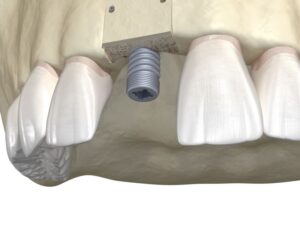
If you plan to receive dental implants, you might be informed that you need a bone graft before you move forward with tooth replacement. While you might be a bit disappointed by the prospect of undergoing an additional surgery, this procedure is actually something to be grateful for! Continue reading below to learn what you should know about bone grafting so you can commit to it with confidence.
Are Bone Grafts Always Necessary?
Not everyone who receives dental implants requires a bone graft. However, if you have lost some bone density or volume, you will likely need this procedure. It is often necessary for people whose jawbones have shrunk due to natural resorption. (Resorption is the human body’s way of recycling unused materials. It occurs in the jaw after the natural teeth are removed and the tooth roots are no longer present to stimulate the bone.)
Bone Grafts: The Basics
During a bone graft, additional bone material is added to the jaw in order to enlarge it so it can successfully support dental implants. There are different types of grafting materials that can be used:
- Autografts use material harvested from a patient’s own body. This ensures good compatibility.
- Allografts are obtained from human donors and carefully processed to reduce the risk of rejection. Allografts can prevent the need for a second surgical site.
- Xenografts come from animal sources. Again, these are carefully processed.
- Alloplastic materials are synthetic, bone-like materials.
The Surgical Process
The bone grafting surgical process is usually straightforward. After an initial consultation, your surgeon will plan the details of your procedure. On the day of your surgery, you will be appropriately anesthetized and sedated so you are comfortable. Then, your surgical team will expose your jawbone, place the grafting material and secure it, then close your gum tissue so you can start healing.
In some cases, dental implants can be placed at the same time a bone graft is performed. In other cases, a waiting period of a few months is necessary between the two procedures.
Benefits of Bone Grafting
Bone grafting offers some outstanding benefits for dental implant patients:
- Improved implant integration. A healthy jawbone is better able to accept dental implants and form a strong bond with them.
- Improved oral function. A strong jawbone can contribute to optimum oral function. For example, you may enjoy enhanced speaking and chewing abilities.
- Aesthetics. A bone graft in the jaw may help to maintain appealing facial contours, which contributes to a more youthful appearance.
- A greater chance of implant success. Having a stable foundation for your implants can reduce the risk of future implant failure.
- Greater accessibility. Bone grafting can make it possible for many patients to receive dental implants, including those who might otherwise never be a good candidate for them.
Bone grafting can play an important role in your tooth replacement journey. Ask your surgeon lots of questions so you can commit to your treatment plan with confidence.
Meet the Practice
Our team works under the leadership of three board-certified oral surgeons: Drs. Steve Koo, Thomas Weil, and William Shepard. We offer a range of advanced dental implant services, including both bone grafting and dental implant placement. If you have questions about how we may be able to serve you, or you are ready to get started on replacing your lost teeth, contact Piney Point Dental Implant Center at 713-597-7340.

